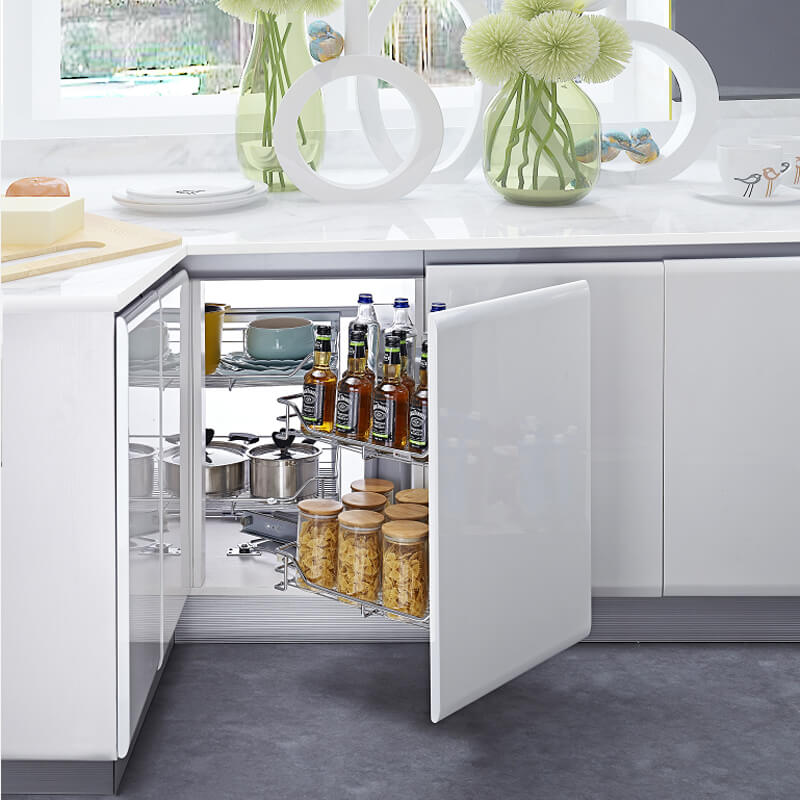How to Make the Most of Your Blind Corner Cabinet
A blind corner cabinet is a form of under-the-counter cabinetry located in an exposed corner where two walls come together. Blind corners are common in homes with open concept floorplans or kitchens that lack wall space. They provide hidden storage within a small footprint, making them suitable for small spaces or prepping areas where countertops might otherwise be crowded. Using blind corner cabinetry takes advantage of otherwise lost space while simultaneously creating a more polished look.
- Make it 2 feet deep:
Most cabinets are 24 inches deep, which allows you to comfortably place them between two walls without having trouble opening and closing the doors. Blind corner cabinets need to be at least 2 feet deep for optimal functionality. This will allow you to hold up to 36 bottles of wine, large baking sheets or serving platters; and still leave enough room outside your cabinet for someone to pass through your kitchen.
- Leave a thin strip behind the door clear:
If you want easy access to items stored inside your blind corner cabinet, make sure that the wall behind is covered in cabinetry. There should be no more than 3 inches of space between your cabinet and the wall. The rest of the space should be covered with an accent piece, like a mirror or artwork.
- Consider a rolling island:
A rolling island is ideal for small spaces where you have limited floor room and open countertop surface. By investing in a mobile island, you can prepare meals while still having plenty of working surface area on your counters. Rolling islands also make it easier to move around and serve dishes without always needing table space. If you have enough wall space available, building one yourself isn’t as difficult as it sounds; just make sure to anchor everything properly so that it’s secure for everyday use.
- Create a pull-out cabinet:
Pull-outs are a great way to make storage more accessible and efficient. They can be used for kitchen items, office supplies or cleaning materials. You can install drawer systems into the bottom of your blind corner cabinets that will allow them to serve double duty as an accessory cabinet; perfect for storing your soup ladle next to the stove. Make sure that you have enough shelf space in front if you build a pull out system inside a blind corner cabinet. Otherwise, you won’t be able to use it effectively.
- Add shelves on top:
Another option is adding shelves on top of your existing cabinetry so that they extend across all three walls creating one large unit with lots of storage space. If you choose to install shelves, we recommend using metal brackets that can support the weight. The cabinet should be anchored into the wall studs for maximum safety and stability.
- Place your appliances against the back wall:
To maximize countertop space, move your appliances so that they are flush with the back wall of your blind corner cabinet. Doing this will allow you to place items on top of the appliance while keeping it hidden away behind closed doors; freeing up valuable countertop space to prepare meals or simply give yourself more room to work.
- Measure twice, cut once:
We cannot stress this enough! Make sure that anything you build fits properly before drilling holes or cutting any boards. One small misstep and you might end up with a piece that doesn’t fit, which can easily lead to costly mistakes. Many of the blind corner cabinets on the market come with pre-drilled holes for shelves or baskets so if you want to add your own personal touch, take measurements and then create your design before using it as a template for drilling holes.
- Utilize high walls:
Blind corner cabinets work best when they have tall walls as opposed to deep pockets where items tend to get lost at the back of the unit. If possible, avoid adding doors that open down because they will be difficult to access if placed over appliances like dishwashers or ovens Automated soft close hinges are a great way to ensure that your doors shut quietly so you don’t wake up anyone in the morning.
- Upgrade when necessary:
Regular cabinetry can show wear and tear over time which can make it appear unsightly if left unchecked. It’s easy enough to sand down cabinets, but sometimes it is better to just replace them with new ones once they start looking worn out. If you choose this option, remember that it’s better to install new cabinets next to your old ones instead of creating a staggered pattern so that the seams are less visible from the front of the kitchen room or countertop area. We also recommend installing LED under cabinet lighting for an even more modern look; not only does it make tasks easier, it also adds a nice touch to accent the new cabinetry.
- Add finishing touches:
Last but not least, remember that there are many ways to personalize your kitchen without spending too much money or time. Additional details like decorative knobs and handles can add personality and flair to your home while making sure that everything is accessible whenever you need it. If you’re doubting how this will look with your overall design, consider painting your cabinets in a contrasting color to give them more presence such as black or white so they stand out against the wall behind them. For an even more custom look, replace the cabinet doors and drawer fronts instead of just painting over them; this ensures uniformity and makes your cabinetry look like it was designed by a professional.

